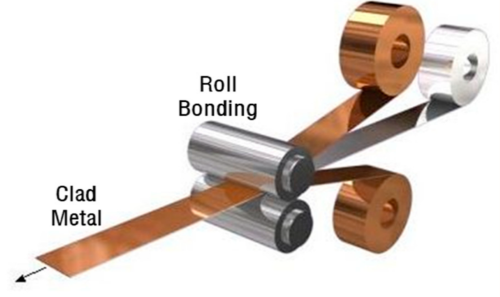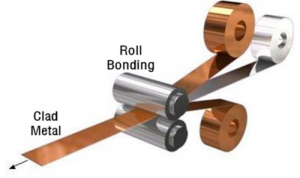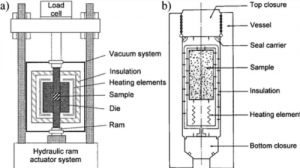Clad Metals: Advanced Materials for Enhanced Performance

Introduction
Clad metals, a composite material created by bonding two or more different metals or alloys, offer a unique combination of properties that are not achievable with a single material. This advanced engineering process allows manufacturers to combine the strengths of different metals, leading to improved performance, cost-effectiveness, and enhanced versatility across a wide range of applications. The following article discusses the process, common types, advantages, and applications.
The Cladding Process
Cladding involves bonding two or more metals under high pressure and temperature, often without the use of an adhesive. There are several methods for achieving this bond, including roll bonding, explosive bonding, diffusion bonding, and hot isostatic pressing (HIP). Each method is chosen based on the specific metals involved and the intended application.
1. Roll Bonding: In this method, metal sheets are cleaned, stacked, and passed through a series of rollers. The intense pressure and, in some cases, heat, cause the metals to bond at the atomic level. Roll bonding is commonly used for large-scale production and is particularly suitable for metals that deform easily
 [1]
[1]
2. Explosive Bonding: This method uses controlled explosions to bond metals. The explosion generates a shock wave that plastically deforms the metals and creates a metallurgical bond. Explosive bonding is often used for metals that are difficult to bond using other methods, such as titanium and stainless steel.
3. Diffusion Bonding: This technique involves heating the metals to a high temperature in a vacuum or inert atmosphere and applying pressure for an extended period. The atoms of the different metals diffuse into each other, creating a strong bond. Diffusion bonding is ideal for applications requiring high-strength and corrosion-resistant materials.
4. Hot Isostatic Pressing (HIP): HIP involves placing the metal components in a high-pressure chamber, heating them, and applying isostatic pressure from all directions. This method is particularly effective for creating complex shapes and for bonding metals with different thermal expansion coefficients.
 [2]
[2]
Common Types of Clad Metals
The choice of materials used in clad metals is driven by the desired properties for specific applications. Here are some common types of clad metals and their typical uses:
- Stainless Steel-Clad Aluminum: This combination is widely used in the automotive and aerospace industries. Stainless steel provides corrosion resistance and strength, while aluminum offers lightweight properties. This type of clad metal is commonly used in car trim, body panels, and aircraft components.
- Copper-Clad Aluminum: Known for its excellent thermal and electrical conductivity, copper-clad aluminum is often used in electrical wiring, connectors, and cookware. The aluminum core reduces the weight and cost, while the copper layer ensures efficient conductivity.
- Nickel-Clad Steel: Nickel-clad steel is favored in the chemical processing industry due to its outstanding resistance to corrosion and high temperatures. It is typically used in reactors, heat exchangers, and pressure vessels that operate in harsh environments.
- Titanium-Clad Steel: This combination is commonly used in the oil and gas industry, particularly for offshore drilling operations. Titanium offers excellent resistance to seawater corrosion, while steel provides the necessary strength and durability for high-pressure environments.
- Aluminum-Clad Steel: Aluminum-clad steel is used in applications where a combination of lightweight, corrosion resistance, and strength is required. It is often found in electrical transmission lines, automotive parts, and architectural elements.
- Copper-Clad Stainless Steel: This type of clad metal is used in decorative applications and in products where both corrosion resistance and a polished appearance are important. It is commonly found in high-end kitchenware, architectural panels, and electrical connectors.
- Silver-Clad Copper: This combination is often used in electrical contacts and components where superior conductivity and corrosion resistance are needed. The silver layer provides excellent electrical performance, while the copper core adds mechanical strength.
Related reading: Titanium Clad Steel Plate & Its Applications
Each type of clad metal is carefully selected based on the specific requirements of the application, taking into consideration factors such as mechanical strength, corrosion resistance, thermal and electrical conductivity, and overall cost. For more advanced metal products, please visit Advanced Refractory Metals (ARM).
Advantages of Clad Metals
Clad metals offer several advantages over monolithic metals, including cost savings, improved mechanical properties, and enhanced corrosion resistance. By selecting specific materials for each layer, manufacturers can tailor the properties of the clad metal to meet the exact requirements of an application.
- Cost-Effectiveness: Clad metals allow the use of a less expensive core material, such as carbon steel, with a thin layer of a more expensive metal, like stainless steel or titanium, on the surface. This approach significantly reduces material costs while maintaining the desired surface properties.
- Improved Mechanical Properties: Cladding can enhance the mechanical properties of metals, such as strength, hardness, and wear resistance. For example, a clad metal with a core of high-strength steel and a surface layer of corrosion-resistant stainless steel can offer both high strength and durability.
- Enhanced Corrosion Resistance: Clad metals are often used in environments where corrosion resistance is critical. The outer layer of corrosion-resistant material protects the underlying metal from exposure to corrosive elements, extending the lifespan of the product.
- Versatility: The ability to combine different metals with varying properties makes clad metals highly versatile. They can be tailored to meet the specific requirements of applications in industries such as aerospace, automotive, chemical processing, and oil and gas.
Applications of Clad Metals
The unique properties of clad metals make them suitable for a wide range of applications, from high-performance industrial components to consumer goods.
- Aerospace Industry: Clad metals are used in the aerospace industry to manufacture lightweight and high-strength components. For instance, aluminum-clad steel is used in aircraft structures to combine the lightweight properties of aluminum with the strength of steel. This combination reduces the overall weight of the aircraft, improving fuel efficiency without compromising structural integrity.
- Automotive Industry: In the automotive industry, clad metals are used to produce components that require a combination of strength, corrosion resistance, and aesthetic appeal. Stainless steel-clad aluminum, for example, is used in car trim and body panels. This material offers the strength and durability of aluminum with the corrosion resistance and polished appearance of stainless steel.
- Chemical Processing: Clad metals are widely used in the chemical processing industry to manufacture reactors, heat exchangers, and pressure vessels. Nickel-clad steel is often used in these applications due to its excellent resistance to corrosion and high temperatures. A case study involving a chemical plant in Texas demonstrated that switching to nickel-clad steel for their heat exchangers resulted in a 50% increase in service life and a significant reduction in maintenance costs.
- Oil and Gas Industry: The oil and gas industry requires materials that can withstand harsh environments, including high pressures, temperatures, and corrosive substances. Titanium-clad steel pipes are used in offshore drilling operations due to their exceptional strength and resistance to seawater corrosion. A notable case involved the installation of titanium-clad steel pipes in an offshore oil rig, which led to a 40% reduction in downtime due to corrosion-related failures.
- Consumer Goods: Clad metals are also found in everyday consumer goods, such as cookware and electronic devices. Copper-clad aluminum, for instance, is used in high-quality cookware due to its excellent thermal conductivity and lightweight properties. In the electronics industry, clad metals are used in connectors and circuit boards to provide reliable electrical conductivity and resistance to corrosion.
Conclusion
Clad metals represent a sophisticated and cost-effective solution for a wide range of industrial and consumer applications. By combining the best properties of different metals, clad materials offer enhanced performance, durability, and versatility.
As industries continue to demand more efficient and reliable materials, the use of clad metals is expected to grow, supported by ongoing advancements in cladding technologies and material science. Whether in aerospace, automotive, chemical processing, or consumer goods, clad metals will continue to play a crucial role in shaping the future of advanced manufacturing.
Reference:
[1] Cho Y-R. Clad Metals: Fabrication, Properties, and Applications. Metals. 2021; 11(8):1186. https://doi.org/10.3390/met11081186
[2] Shi, Zhuoqi & Zhao, Qingliang & Guo, Bing & Ji, Tianyu & Wang, Hao. (2020). A review on processing polycrystalline magnesium aluminate spinel (MgAl2O4): Sintering techniques, material properties and machinability. Materials & Design. 193. 108858. 10.1016/j.matdes.2020.108858.
{{item.content}}
LEVE A REPLY
{{item.children[0].content}}
{{item.content}}






